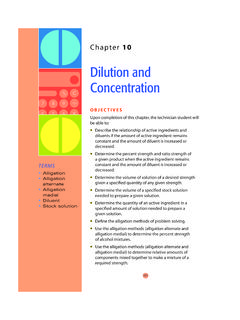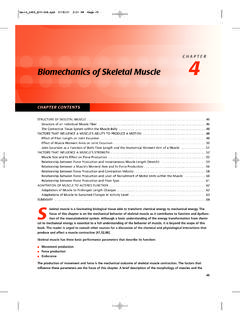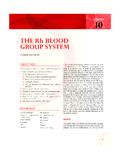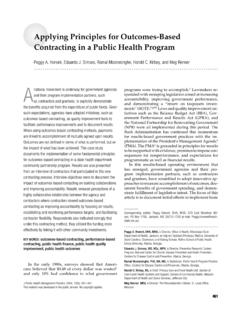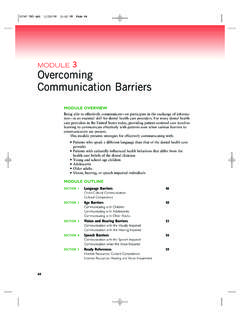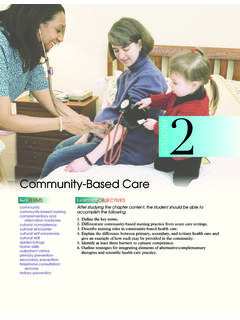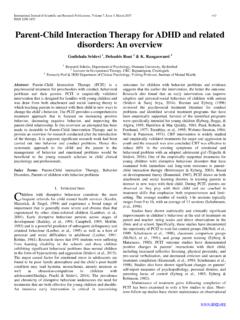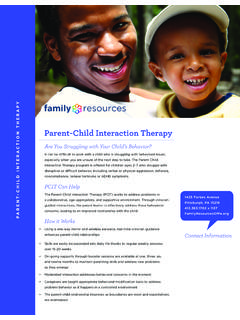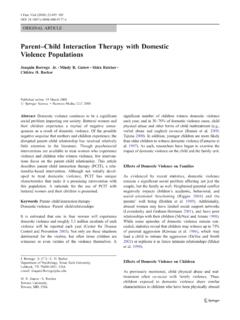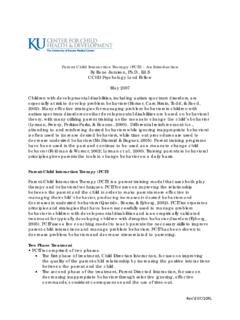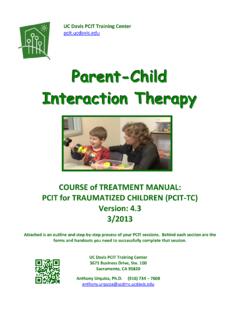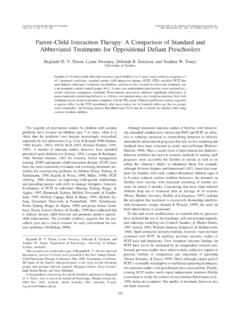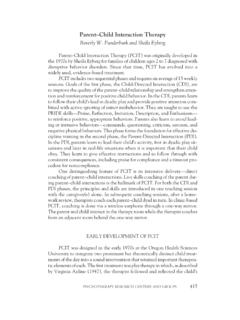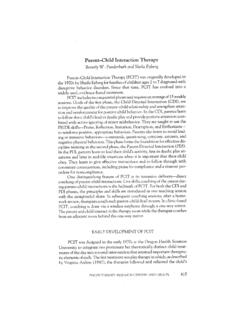Transcription of PalinParent–ChildInteraction
1 CHAPTER5 Palin Parent child InteractionWILLIEBOTTERILL ANDELAINEKELMANCHAPTER OUTLINEINTRODUCTIONP rinciples of Treatment: parents (or KeyCaregivers) Are Involved inDirecting and Delivering Therapyin the HomePrinciples of Treatment: Understandingthe child s NeedsPrinciples of Treatment: Stuttering IsDiscussed OpenlyPrinciples of Treatment: parents AreAlready HelpingGoals of TreatmentTHEORETICAL BASIS FOR TREATMENTAPPROACHF actors That May Contribute to the Onset ofStutteringFactors That Contribute to theDevelopment of Stuttering andRisk of PersistenceFactors That Contribute to the Moment ofStutteringThe Michael Palin Centre MultifactorialFrameworkAssessment and TherapyProfile of VulnerabilityTherapy PalinPCIEMPIRICAL BASIS FOR TREATMENTP hase 1 Phase 2 Phase 3 Phase 4 Phase 5 SummaryPRACTICAL REQUIREMENTST rainingAssessment SkillsTherapeutic SkillsTechnical Equipment and SkillsAccommodationTime RequirementsKEY COMPONENTSO verviewMultifactorial
2 AssessmentStage 1: Within Clinic SessionsStage 2: The Home-Based ConsolidationPeriodStage 3: The Review Session and ClinicalDecision MakingAdvantages of Palin PCIS ummaryASSESSMENT METHODS TO SUPPORTONGOING DECISION MAKINGI nitial Assessment to Support DecisionMaking Regarding InterventionOngoing Assessment to Monitor TreatmentEffectivenessTAILORING THE TREATMENT TO THEINDIVIDUAL CLIENTAPPLICATION TO AN INDIVIDUAL CHILDS ession 1 Session 2 Session 3 Session 4 Session 5 Session 6 CASE STUDYCase Study QuestionsFUTURE DIRECTIONST rainingApplication of Palin PCI to Other DisordersResearchSummaryCHAPTER SUMMARYCHAPTER REVIEW QUESTIONSSUGGESTED READINGSKEY TERMSP alin Parent child Interaction.
3 Therapypro-gram using video feedback to help parentsdevelop styles of interaction to facilitate theirchild s perspective: a number of differ-ent factors may be relevant in the onset, de-velopment, and persistence of a stutteringproblem and are therefore also considered inits Time: 5-minute, play-based sessionsfor the parent and child to practice specificfluency-facilitating targets in the Parent child Interaction(Palin PCI)(Kelman & Nicholas, 2008) is a therapy programconducted at the Michael Palin Centre (PalinCentre) for children up to 7 years of age that usesplay-based sessions with parent child pairs, videofeedback, and facilitated discussions to helpparents support and increase their child s naturalfluency.
4 It is often the first and only interventionfor young children at the Palin Centre. It differsfrom other approaches to modifying parent childinteraction in the following ways: It is a facilitative rather than an instructiveapproach: parents instinctive expertise is eli-cited, reinforced, and developed. parents use video feedback to set their owntargets and reinforce are some children who also benefitfrom other interventions such as language ther-apy or speech sound work, as indicated, oncePalin PCI has been OF TREATMENT:UNDERSTANDING THECHILD S NEEDSP alin PCI is based on the therapist s andparents shared understanding of the child s par-ticular profile of speech motor and linguisticstrengths and vulnerabilities.
5 These are identi-fied during the assessment and provide the con-text for exploring whatthe child needs in orderto plan, organize, and deliver a message OF TREATMENT: parents ARE ALREADY HELPINGA key principle is that parents of children whostutter are already interacting with their chil-dren in ways that support natural fluency. Theyoung children seen at the Palin Centre are flu-ent much more often than they stutter. Parentsseek help because they are worried about the de-velopment of persistent stuttering, and they feelill equipped to help their child . Palin PCI pro-vides the means by which parents becomeincreasingly knowledgeable about their child scommunication skills and helps them to identifywhat they do that supports the development offluency.
6 Palin PCI aims to empower and rein-force parents ability to interact in ways thatmatch the child s fluency needs and focus onincreasing these interactions in the OF TREATMENT: parents (OR KEY CAREGIVERS)ARE INVOLVED IN DIRECTINGAND DELIVERING THERAPYIN THE HOMEP alinPCIisbasedontheprinciplethatparentin volvement in therapy is essential to reducestuttering in the young child . Where appropri-ate, both parents attend the initial assessmentand all therapy sessions, carry out homeworktasks with their child , and provide feedback onprogress. Central to this approach is the estab-lishment of a collaborative therapeutic relation-ship in which the parents and the therapist sknowledge and perceptions are shared and inwhich parents are encouraged to make theirown observations, draw their own conclusions,set their own goals, and reflect on their progresseach week.
7 Within this relationship, the thera-pist s role is to facilitate and affirm, rather thaninstruct, advise, or OF TREATMENT:STUTTERING IS DISCUSSED OPENLYP arents are encouraged to acknowledge stutter-ing openly; they are helpedtoidentifytheirfearsabout acknowledging stuttering and are encour-aged to use age-appropriate, child -centered ter-minology. Normalizing the problem from thebeginning can substantially reduce the anxietyand fear associated with stuttering for parentsand for children. Although anxiety does notcause stuttering, stuttering causes OF TREATMENTThe primary goal of Palin PCI is to establish afoundation of parental understanding, knowl-edge, skill, and confidence in managing stutter-ing, which will support and augment the child sfluency during each stage of therapy .
8 Anothergoal is to reduce the family s anxiety about stut-tering and ultimatelyreduce theinstancesof stut-tering in young children to within normal of StutteringTHEORETICAL BASIS FORTREATMENT APPROACHIt is our view that any therapeutic approach toearly stuttering must not only account for themany factors that may be contributing to theonset and development of stuttering in the indi-vidual child , but also acknowledge and harnessthe strengths and resources that the child andfamily bring to the clinical setting. This under-standing of the nature of each child s difficultiesas well as their strengths informs the therapyprocess from the perspective(Smith &Kelly, 1997; Starkweather & Gottwald, 1990;Wall & Meyers, 1995) is supported by growingevidence that there arefactors that may accountfor the child s underlying vulnerability to stut-tering and its onset; factors that contribute tothe development of the problem and, in somecases, its persistence.
9 And factors that contributeto the moment of THAT MAY CONTRIBUTETO THE ONSET OF STUTTERINGG eneticsThe underlying vulnerabilities to stuttering arehighly complex and continue to be the focus ofextensive research. It seems incontrovertiblethat genetic factors play a role in the onset ofstuttering, and linkage studies are getting closerto finding the specific genes that predisposechildren to the disorder (Cox et al., 2000;Drayna, 1997; Shugart et al., 2004; Suresh et al.,2006). However, it is important to note thatgenes alone do not produce or determine behav-ior, especially one as complex and variable asstuttering; they only increase the probabilitythat it will occur (Starkweather, 2002).
10 It isacknowledged that a wide range of factors influ-ences the extent to which a behavior trait suchas stuttering finds expression (Starkweather,2002). The complexity of the genetic predispo-sition was also discussed by Ambrose, Cox, andYairi (1997), who suggested that an otherfactor such as rapid rate of speech, low toler-ance for frustration, slow reaction time, wordretrieval or sentence formulation skills, chronicor excessive muscle tension, or any combinationof these may be the inherited variable thatresults in stuttered addition to whether or not stuttering islikely to occur, Ambrose, Cox, and Yairi (1997)and Suresh et al.
